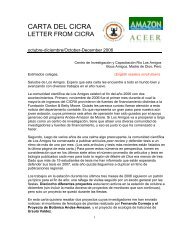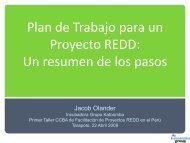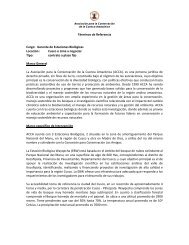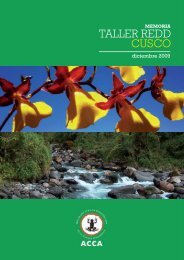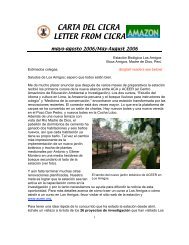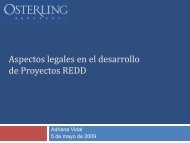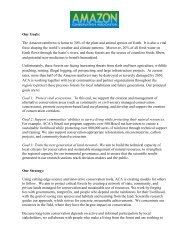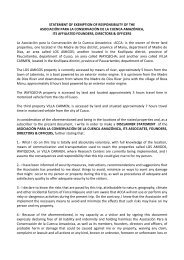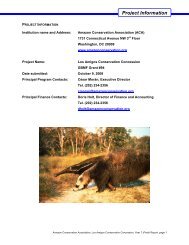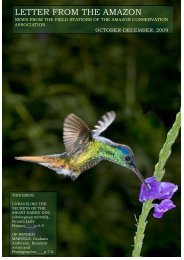LETTER FROM THE AMAZON - Amazon Conservation Association
LETTER FROM THE AMAZON - Amazon Conservation Association
LETTER FROM THE AMAZON - Amazon Conservation Association
You also want an ePaper? Increase the reach of your titles
YUMPU automatically turns print PDFs into web optimized ePapers that Google loves.
Letter from the <strong>Amazon</strong> January-March, 2010<br />
Fins and Feathers<br />
Letter from the director:<br />
Dr. Adrian Tejedor, Director of Research<br />
How does a research station benefit me? Why should I<br />
care about science? One reason these questions always<br />
crop up is that the answer is not straightforward. The<br />
benefits of science surround us in agriculture,<br />
technology, and medicine but the link between the<br />
original bits of discovery and their practical applications<br />
is rarely direct or well publicized.<br />
How many hundreds of millions of us owe our existence<br />
to the penicillin used by our ancestors - only one or two<br />
generations back - to cure infections that before the<br />
1950s were life-threatening? Who could have foreseen<br />
that this savior antibiotic would come from a mold whose<br />
effects were discovered by serendipity and put to work<br />
only 20 years later? Given enough time, the rummaging<br />
of scientists, often demeaned by non-specialists as the<br />
search of the ‘leg of an ant, the fin of a little fish, or the<br />
feather of a bird’, can have momentous consequences<br />
for the quality of life of everyone on Earth.<br />
Macaws, renowned for their beautiful feathers, by Sarah<br />
Federman.<br />
At its research stations, CICRA and Wayqecha, ACCA<br />
seeks to foster both pure and applied science to solve<br />
the most pressing environmental issues of the southern<br />
Peruvian <strong>Amazon</strong> and the Andean cloud forest. In<br />
addition to updates of the many projects and activities at<br />
our stations, in this issue of the Letter from the <strong>Amazon</strong>,<br />
you will find answers to one of the region’s most urgent<br />
questions: how badly is mercury, used in gold mining in<br />
the Madre de Dios River, contaminating aquatic and<br />
terrestrial ecosystems? The evidence has come from, of<br />
all things, fi ns and feathers.<br />
Looking at the muscle at the base of the dorsal fin of<br />
fish, CICRA’s grant program awardee Dr. Luis<br />
Fernandez has figured out to what degree river fish, an<br />
important source of protein in the <strong>Amazon</strong>, are being<br />
contaminated by mercury. As you will read, the little fish<br />
turn out to be the least contaminated and the best to eat.<br />
Madre de Dios River by Sarah Federman.<br />
Feathers, on the other hand, show us that mercury is<br />
traveling away from the rivers through the food chain.<br />
This story is told by Margaret (Peggy) Shrum, a longterm<br />
researcher at CICRA who has discovered<br />
potentially lethal concentrations of this toxic metal in the<br />
<strong>Amazon</strong>’s top aerial predators: birds of prey. If this<br />
pattern repeats in terrestrial food chains, it may indicate<br />
that mercury contamination, with origins in river mining,<br />
could reach further into terrestrial ecosystems and<br />
persist for a longer time than previously realized.<br />
These examples demonstrate that science can help us<br />
make sensible choices when deciding what to eat or<br />
where to look for what we eat in the Peruvian <strong>Amazon</strong>.<br />
So then, should we fund scientists proposing to study<br />
legs, fins, or feathers? I think we should.<br />
The Andes glimpsed beyond the rainforest’s canopy; a sight to<br />
revel in, a view worth protecting, by Sarah Federman.<br />
3



